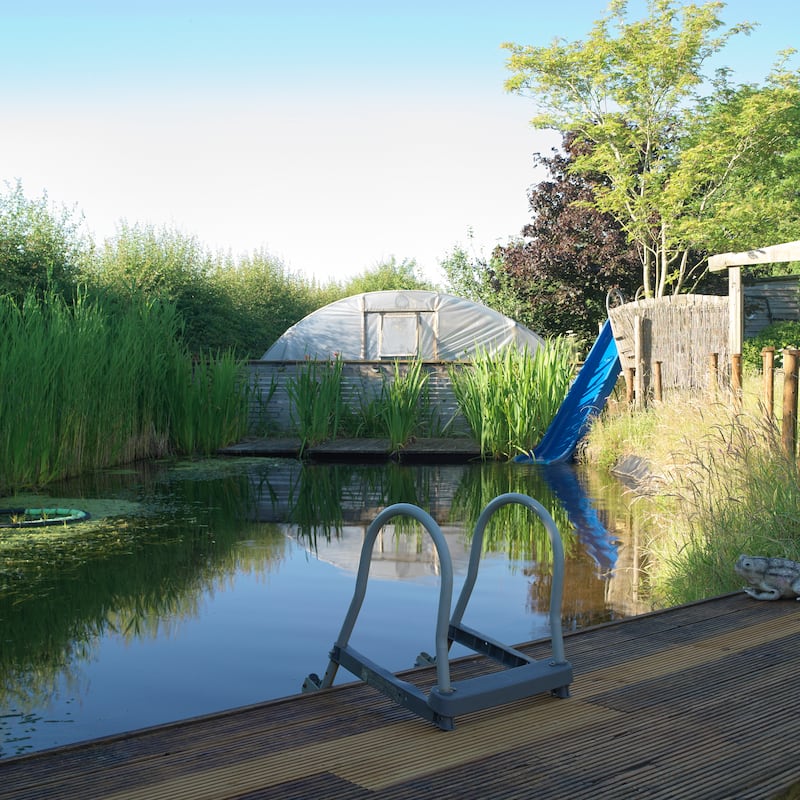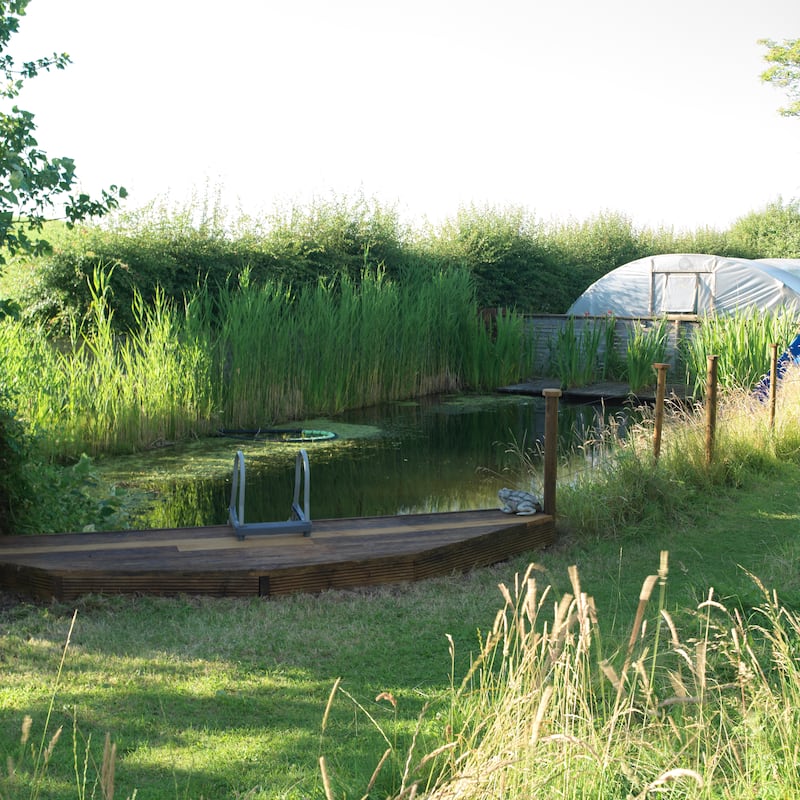While many of us might entertain dreams of one day having our very own pool, the Laois-based artist and permaculturist Marc Rome went ahead and made one for himself and his family to enjoy.
It helps, of course, that Rome is the sort of person who can build pretty much anything from scratch, a master carpenter and natural DIYer with an engineering mind innately hardwired to see possibilities and seek out solutions.
In the case of his family’s swimming pool, it started very simply several years ago with a small, natural hollow, in the contours of the pretty, productive country garden near Durrow that he shares with his partner, the photographer and teacher Annie Holland and their three children.
“Whenever it rained heavily, this natural hollow in the ground would fill up with water and our kids loved to play in it. So I gradually enlarged it, lined it with some strong black plastic sheeting as a sort of temporary solution, and told them that if they liked it that much, we could look at creating a proper permanent swimming pool in the same spot.”
READ MORE

The natural swimming pool that Rome went on to make is a very far cry from conventional modern swimming pools with their heavy reliance on environmentally-harmful chemical interventions and complex, expensive filtration and heating systems designed to keep the water warm and clean.
Instead, it sits entirely comfortably within the rural site, looking for all the world like it’s always been there. Softly rectangular in shape (it measures approximately 16m x 6m), its edges are blurred by the generous swathes of native reeds, rushes and flag irises that grow in the two separate regeneration and filtration zones immediately adjoining it. Their primary role (along with a low-tech garden pump) is to help oxygenate, filter and purify the pond water and prevent algae from forming. The non-chlorinated water produced is so reliably clean that a rich variety of wildlife — hedgehogs, frogs, newts, dragonflies and mayflies — have gradually taken up residence in the family’s organically-managed garden, all appreciative of the habitat-rich environment that the pool supports.
“A large area of pure, clean water like this is always such a huge magnet for nature,” Marc says. “It’s as if we’ve created our very own version of Watership Down.”
Garden wildlife aside, the humans that enjoy this natural swimming pool are every bit as appreciative. On baking hot summer days and nights, there’s no nicer way to cool down. “It typically stays just a few degrees cooler than the ambient air temperature, so in the sort of weather that we’ve been having recently, it’s lovely and warm but still really nice and refreshing to swim in,” says Annie.

Even on spring and autumn days, it provides the sort of bracing, endorphin-boosting, health-enhancing dip that advocates of wild swimming speak of with such fervour, especially when combined with a session in the garden’s nearby sauna room that Marc has also built entirely from scratch.
As well as providing the perfect backdrop for many memorable garden parties, this natural swimming pool plays an instructional role too. The couple’s children learned to swim in it, as have those of family and friends, while its role in supporting biodiversity has provided countless opportunities to witness nature close-up, helping to nourish and sustain a deep love and knowledge of the natural world.
It also serves as an important testament to Rome and Holland’s long commitment to the principles of permaculture, a holistic approach to the planet and all the many different kinds of life forms that depend upon it.
“I suspect that a lot of people misunderstand the idea of permaculture, that there’s just this vague sense that it’s got something to do with growing plants or living in harmony with nature,” says Marc. “But at its heart, along with a deep respect for the earth, its life systems and all who depend upon its limited resources, is the idea that if something can be repurposed rather than just sent to landfill — I much prefer to use the term ‘repurposed’ rather than ‘upcycled’ or ‘recycled’— then it should be.”

In the case of the pool, this means that the materials used in its construction were salvaged and reused wherever possible. Examples include the old carpets and polystyrene insulation donated by friends that now help to protect the pool’s all-important butyl rubber liner, the old garden slide that now doubles-up as a water slide, the repurposed decking, the childproof fence encircling it made from paracord. Even the organic material that very slowly collects in the pond’s pump filter is eventually recycled in the family’s polytunnel as a nutrient-rich mulch.
Inspired by the same core principles of permaculture, Rome now offers a consultancy service to share his knowledge of building these sorts of nature-friendly swimming pools. His aim, he says, is to create the kinds of swimming pools that are both respectful of nature and the specific site in which they sit. “To design something that’s completely in tune with the shape and contours of a garden, its habitats, the surrounding landscape… that will always be my goal.”
How does it work?
Unlike conventional swimming pools, natural swimming pools avoid the use of environmentally-harmful chemicals and high-tech, energy-costly filtration equipment and instead harness the power of plants to help oxygenate and filter the water.
In the case of this particular natural swimming pool, it’s been designed using a combination of water-purifying aquatic plants and a low-tech water pump. The plants, which perform roughly 30 per cent of the job of cleaning and filtering the water, are grown in what are called regeneration and filtration zones, two immediately adjoining areas that are physically separate and distinct from the main pool itself.
The shallower of these two zones — effectively a reed bed — sits along one entire length of the pool. Built to a varying depth of between just 20cm-50cm and separated from the main pool by a concealed wall, it’s partially filled with stones and planted with native water reeds and rushes propagated from specimens that Rome gathered locally in the wild. Its shallow waters also serve a second useful purpose, which is to act a bit like a large rock pool, helping to naturally heat the main pool as the water very slowly overflows into it.

The second, deeper regeneration and filtration zone, which is filled with native flag irises, is partially concealed by handsome wooden decking. Built to a depth of 1m to accommodate the irises’ larger, deeper, more questing root-systems, it also helps to warm the water in the main pool and is also separated from it by a hidden wall that prevents soil and plant matter from leaching into the latter.
The pool itself was carefully excavated to give both a child-friendly, shallow end (maximum depth of 1.3m) and a deep end (2m). After excavation, the ground was packed down firmly and then covered with a 10cm layer of builders sand, followed by a layer of old carpet and polystyrene insulation, followed by a root-proof fleece underlay, followed by a very high-quality Firestone flexible rubber-butyl liner with a 40-year guarantee. The electric pump sits in the shallow area of the pool. Manufactured by Oase, it’s been chosen to suit the water capacity of the pool, which is 117,000 litres.
This week in the garden
The hot, dry weather of recent week had put many container-grown plants under stress so make sure to water them extra generously and to keep a vigilant eye out for signs that plants are struggling including wilting/discoloured foliage, dropped flower buds or reduced flowering/fruiting. Badly dehydrated pots should be placed up to their waists overnight in a large container of cool, clean water and then given a liquid feed once the plants have recovered.
Rather than deadheading them, many early-summer flowering biennials such as foxgloves, honesty and sweet william can be left to set seed at this time of year. Leave the faded flower stems on the plants until later this summer, when the seed will have properly ripened, at which point it can be saved or sprinkled around the garden to provide young seedlings.
Dates for your diary
From July 22nd–August 1st: This year’s Carlow Garden Festival will take place with a wide variety of talks, garden visits and workshops in some of Carlow, Laois and Kildare’s loveliest gardens by a range of experts including James Alexander Sinclair, Adam Frost, Leonie Cornelius, Joe Swift, Arthur Shackleton, Shirley Lanigan, Turtle Bunbury, Arthur Cole, Orlaith Murphy, Stephanie Hafferty, Belinda Jupp, James Wong, Tom Coward, Jim Gardiner, Ken Cox, Finola Reid, Fiann O’Nuallain, Éanna Ní Lamhna and Fionnuala Fallon. See carlowgardentrail.com for more.
Friday July 29th–30th July: In Maynooth University, Co Kildare, the 74th Annual FIBKA Beekeeping Summer School will take place with a wealth of talks, training sessions, practical workshops and demonstrations, trade stands and exhibits plus the Irish National Honey Show. See irishbeekeeping.ie for more.




















